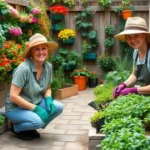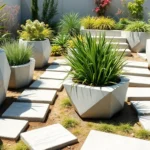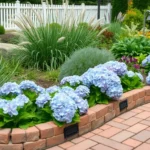We’ve all walked through gardens that feel scattered and unfocused, lacking that special something that draws the eye and creates visual magic. The secret to transforming any outdoor space from ordinary to extraordinary lies in creating compelling focal points that anchor your garden’s design and tell a story.
Garden focal points aren’t just decorative afterthoughts – they’re strategic design elements that guide visitors through your space while showcasing your personal style. Whether you’re working with a sprawling backyard or a cozy urban plot, the right focal point can make your garden feel intentional, cohesive, and utterly captivating.
From dramatic sculptures and water features to carefully curated plant arrangements and architectural elements, we’ll explore proven focal point ideas that transform gardens into memorable outdoor experiences. These design strategies will help you create those Instagram-worthy moments while building a space that brings joy year-round.
Create Drama With Water Features That Command Attention
Water features instantly transform any garden space into a captivating retreat that engages multiple senses. We’ll explore three powerful ways to incorporate water elements that serve as stunning focal points while adding movement and sound to your outdoor sanctuary.
Install a Striking Fountain as Your Central Element
Position a fountain strategically to maximize its visual and auditory impact throughout your garden space. We recommend placing tiered fountains along main pathways or at the intersection of garden rooms where they naturally draw the eye. Classical stone fountains work beautifully in traditional settings while contemporary metal designs complement modern landscapes.
Choose the right scale for your fountain to ensure it commands attention without overwhelming surrounding plantings. Large estate gardens can accommodate grand multi-tiered fountains reaching 6-8 feet in height. Smaller courtyard spaces benefit from compact tabletop fountains or wall-mounted options that still provide the desired water sound without dominating the area.
Consider pump power and maintenance requirements when selecting your fountain design. Solar-powered fountains offer eco-friendly operation in sunny locations while electric models provide consistent water flow regardless of weather conditions. We suggest installing a timer system to control operating hours and reduce energy consumption.
Design a Peaceful Pond With Natural Stone Edges
Create organic shapes that mimic natural water bodies rather than geometric forms for maximum visual appeal. We prefer kidney or teardrop pond configurations that blend seamlessly with industry contours. These irregular shapes provide multiple viewing angles and create more interesting reflections on the water surface.
Select appropriate stone materials that complement your existing hardscape elements and regional geology. Flagstone edges offer flat surfaces for seating and plant placement while fieldstone creates a more naturalistic appearance. We recommend using stones that are at least 2-3 inches thick to prevent cracking from freeze-thaw cycles.
Plan for proper depth zones to support both aquatic plants and fish if desired. Shallow areas of 6-12 inches work well for marginal plants like cattails and water lilies. Deeper sections of 24-36 inches provide fish habitat and prevent complete freezing in colder climates.
Install effective filtration systems to maintain clear water and healthy aquatic ecosystems. Biological filters combined with UV clarifiers help control algae growth while beneficial bacteria break down organic waste. We suggest sizing your filtration system to handle 1.5 times your pond’s total volume for optimal water quality.
Add a Modern Water Wall for Contemporary Appeal
Mount sleek water walls on existing structures or create freestanding installations that serve as living artwork. We recommend stainless steel or copper panels that develop beautiful patinas over time. Glass water walls offer transparency while creating stunning light effects as water cascades down their surfaces.
Incorporate LED lighting systems to extend your water wall’s visual impact into evening hours. Color-changing lights can highlight special occasions while warm white illumination provides subtle ambiance for daily enjoyment. We suggest installing programmable systems that automatically adjust brightness based on ambient light levels.
Design water collection systems that recirculate efficiently while minimizing splash and noise. Hidden reservoir tanks collect water at the base while submersible pumps maintain steady flow rates. We recommend variable speed pumps that allow you to adjust water flow based on wind conditions and desired sound levels.
Plant complementary vegetation around your water wall to soften hard edges and create seamless transitions. Ornamental grasses like fountain grass or Japanese forest grass provide movement that echoes the water’s flow. We suggest adding evergreen shrubs for year-round structure and seasonal flowering plants for color accents.
Transform Your Space With Eye-Catching Garden Structures

Moving beyond water features, we’ll explore how architectural elements can create stunning focal points that define and enhance your outdoor living spaces. These permanent structures serve as the backbone of exceptional garden design.
Build a Pergola to Frame Your Outdoor Living Area
Pergolas create an immediate sense of intimacy and purpose in your garden space. These versatile structures provide essential shade during hot summer months while establishing a clear boundary for outdoor entertaining areas. We recommend positioning your pergola over patios, dining spaces, or walkways to maximize its functional and aesthetic impact.
Transform your pergola into a living architectural element by training climbing vines like wisteria, clematis, or grape vines across its framework. The interplay between structured beams and organic plant growth creates visual interest throughout the seasons. During spring and summer, flowering vines add bursts of color and fragrance, while autumn brings dramatic foliage changes.
Consider the scale of your pergola carefully to ensure it complements rather than overwhelms your space. A standard 8×10 foot pergola works well for most residential patios, providing adequate coverage without dominating the industry. Materials like cedar or pressure treated lumber offer durability and natural beauty that ages gracefully in outdoor conditions.
Construct an Arbor as a Gateway to Garden Rooms
Arbors function as elegant transitions between different areas of your garden, creating the sensation of moving through distinct outdoor rooms. These charming structures work particularly well at pathway entrances, garden bed borders, or between formal and informal industry areas. We suggest using arbors to frame views of special garden features beyond, drawing visitors deeper into your industry.
Climbing plants transform simple arbor frameworks into lush, living sculptures that change with the seasons. Popular choices include roses for romantic appeal, jasmine for evening fragrance, or honeysuckle for attracting beneficial pollinators. The key lies in selecting plants that match your climate zone and maintenance preferences.
Positioning your arbor requires careful consideration of sight lines and foot traffic patterns. Place it where it naturally guides movement while framing an appealing view or destination. Standard arbor dimensions of 4 feet wide by 7 feet tall accommodate most walkways comfortably while providing adequate growing space for climbing plants.
Install a Gazebo for Year-Round Visual Interest
Gazebos serve as permanent garden anchors that provide visual weight and destination appeal regardless of season. These substantial structures create natural gathering spots for outdoor entertaining while adding architectural sophistication to your industry design. We find that gazebos work exceptionally well as central focal points in larger gardens or as intimate retreats in smaller spaces.
Strategic placement maximizes your gazebo’s impact as both a visual and functional element. Consider positioning it where it can be viewed from multiple angles, such as from your home’s main windows or along primary garden pathways. This ensures your investment provides continuous visual enjoyment even when you’re not actively using the space.
Enhance your gazebo’s appeal with thoughtful lighting, comfortable seating, and seasonal decorations. String lights create magical evening ambiance, while weather resistant furniture ensures year round usability. During winter months, evergreen arrangements or weather proof decorations maintain visual interest when other garden elements are dormant.
Make a Statement With Bold Sculptural Elements

Sculptural elements transform gardens into artistic galleries while creating powerful visual anchors that define outdoor spaces. We’ll explore three distinct approaches to incorporating sculptures that make lasting impressions.
Choose Large-Scale Garden Sculptures for Maximum Impact
Large-scale garden sculptures create dramatic focal points that command attention from multiple vantage points throughout your industry. We recommend selecting pieces that stand at least 4-6 feet tall to ensure they maintain visual prominence among surrounding plantings and structures.
Bold sculptures work best when positioned strategically along sight lines or at pathway intersections where they naturally draw the eye. Consider abstract forms in weathered steel or carved stone that complement your garden’s existing textures and materials. These substantial pieces anchor entire garden sections while providing year-round interest that doesn’t rely on seasonal plantings.
Scale matters significantly when choosing impactful sculptures, as pieces too small get lost among foliage while oversized elements can overwhelm intimate garden spaces. We suggest measuring your intended location and selecting sculptures that occupy roughly one-third of the available vertical space for optimal visual balance.
Create Artistic Displays With Modern Metal Installations
Modern metal installations add contemporary flair and artistic sophistication to garden designs while introducing ever-changing elements that change throughout the day. We favor corten steel, stainless steel, and powder-coated aluminum for their durability and weather resistance in outdoor environments.
Geometric forms like spirals, cubes, and abstract configurations create striking contrasts against organic garden shapes and flowing plant forms. These installations often feature interesting shadow patterns that shift with the sun’s movement, adding temporal dimension to your garden’s visual story.
Position metal artworks where they catch and reflect light for maximum impact, particularly near water features or open lawn areas where their forms remain unobstructed. We recommend grouping smaller metal pieces in odd numbers to create cohesive artistic vignettes that feel intentional rather than randomly placed.
Incorporate Classical Statues for Timeless Elegance
Classical statues provide sophisticated focal points that bring historical gravitas and refined beauty to formal garden settings. We find that traditional materials like marble, cast stone, and bronze create the most authentic and enduring appeal in classical garden designs.
Mythological figures, classical busts, and architectural elements like urns or obelisks work particularly well in structured garden layouts with defined pathways and geometric planting beds. These pieces require thoughtful placement on pedestals or within specially designed alcoves that frame and elevate their presence.
Weathering adds character to classical sculptures over time, creating natural patina that enhances their authentic appearance and integration with garden elements. We suggest selecting pieces appropriate to your garden’s scale, with smaller intimate gardens benefiting from modest busts or decorative urns rather than monumental statuary that might overwhelm the space.
Design Stunning Plant Arrangements That Draw the Eye

Plant arrangements transform ordinary gardens into extraordinary landscapes through strategic design and thoughtful placement. We’ll explore three powerful approaches that create visual anchors and guide the eye through your outdoor space.
Plant a Show-Stopping Tree as Your Anchor Point
Trees serve as the foundation of compelling garden focal points when chosen for their striking visual characteristics. We recommend selecting ornamental trees with beautiful bark textures, unique branching patterns, or vibrant seasonal foliage that commands attention year round.
Strategic placement maximizes your tree’s impact throughout the garden design. Position your anchor tree at the center of garden paths or at the beginning of walkways to naturally guide visitors through your industry. Trees with weeping forms like Japanese maples or flowering specimens such as cherry blossoms create dramatic silhouettes that draw the eye from multiple viewing angles.
Seasonal interest ensures your tree focal point remains captivating throughout the year. Consider trees that offer spring blooms, summer shade, autumn color, and winter structure to maintain visual appeal across all seasons.
Create Colorful Flower Beds in Geometric Patterns
Geometric flower bed designs create sophisticated focal points that blend artistry with horticulture. We suggest using contrasting colors and varying plant heights to emphasize the geometric shapes and create visual depth within your arrangements.
Mass planting techniques deliver the most powerful visual impact in formal garden settings. Plant large groups of single bloom colors to create blocks of intense color that read clearly from a distance. This approach works particularly well with annuals like marigolds, petunias, or impatiens that maintain consistent color throughout the growing season.
Pattern variations offer endless possibilities for creative expression in your garden design. Square parterres filled with alternating colors, circular medallions with radiating plant bands, or triangular sections with graduated heights all serve as compelling focal points that showcase your design skills.
Design a Living Wall With Vertical Garden Displays
Vertical gardens maximize visual impact while conserving ground space through innovative structural approaches. We recommend using sturdy frameworks like trellises, wall mounted planters, or custom built structures that can support the weight of mature plants and growing medium.
Plant selection determines the success and longevity of your vertical garden focal point. Choose plants with varying textures, colors, and growth habits to create visual interest at different levels. Combine trailing varieties like ivy or nasturtiums with upright growers such as ferns or small shrubs for maximum diversity.
Maintenance accessibility ensures your living wall remains healthy and attractive over time. Design your vertical garden with adequate spacing between plants for air circulation and easy access for watering, pruning, and plant replacement when necessary.
Add Functional Beauty With Multi-Purpose Focal Points

We can maximize our garden’s impact by choosing focal points that serve multiple purposes while creating stunning visual anchors. These elements combine practical functionality with aesthetic appeal to enhance our outdoor living experience.
Install Fire Pits for Warmth and Gathering Spaces
Fire pits transform any garden space into a central gathering point that provides both warmth and social connection. We’ll want to position our fire pit as the heart of our outdoor entertaining area where family and friends naturally congregate during cooler evenings.
Creating inviting seating arrangements around the fire pit establishes a cohesive focal point that draws people together. We can arrange benches or comfortable garden chairs in a circular pattern to encourage conversation while ensuring everyone enjoys the warmth equally.
Safety considerations should guide our fire pit placement at least 10 feet away from structures and overhanging branches. We’ll need to check local fire codes and consider portable options versus permanent installations based on our exact needs and regulations.
Create Outdoor Dining Areas With Stylish Furniture Sets
Outdoor dining furniture serves as an elegant focal point that invites extended outdoor living and entertaining. We can choose vibrant colors or sophisticated neutral tones to create a dining space that complements our garden’s overall design aesthetic.
Strategic placement of our dining set creates natural gathering spots that become central features in our industry design. We’ll want to position the furniture where it catches morning light for breakfast or evening shade for dinner depending on our preferred dining times.
Decorative elements like wind spinners or bird baths near our dining area enhance the setting while maintaining the functional focus. We can add weather resistant cushions and outdoor lighting to extend the usability of our dining space throughout different seasons.
Build Raised Garden Beds With Decorative Borders
Raised garden beds with attractive borders create structured focal points that showcase our favorite plants while improving growing conditions. We can use natural stone materials or decorative edging to define clean lines that add architectural interest to our industry.
Pathway intersections offer perfect opportunities to place glazed containers or ornamental plantings that guide visitors through our garden design. We’ll position these elements at decision points where paths meet to create natural stopping points that encourage exploration.
Height variations in our raised beds create visual rhythm and depth that keeps the eye engaged throughout the garden space. We can incorporate different materials like wood timber or stone blocks to match our home’s architectural style while maintaining practical growing space for our plants.
Illuminate Your Garden With Strategic Lighting Features

Lighting transforms your carefully crafted focal points into enchanting evening displays that extend your garden’s beauty well beyond daylight hours. Strategic illumination enhances these elements while creating an entirely new nighttime industry experience.
Install Statement Light Fixtures for Evening Drama
Statement light fixtures serve as both functional illumination and captivating focal points that command attention after sunset. Large pendant lights suspended from pergola beams create intimate gathering spaces while casting dramatic shadows across seating areas. Modern sculptural fixtures made from materials like brushed copper or geometric steel designs become artistic elements themselves during daylight hours.
Solar powered options provide eco friendly answers that eliminate complex wiring requirements while maintaining consistent evening performance. These fixtures charge automatically during daylight and illuminate for 6 to 8 hours nightly without increasing electricity costs. Position statement fixtures at key intersection points where pathways meet or above water features to create multiple layers of visual interest.
Chandeliers designed for outdoor use bring unexpected elegance to garden spaces when hung from sturdy tree branches or pergola structures. Weather resistant crystal or metal designs withstand seasonal changes while providing sophisticated ambiance for outdoor dining areas. Choose fixtures that complement your garden’s existing architectural elements to maintain design cohesion.
Create Pathway Lighting to Guide and Enchant
Low voltage LED strip lights embedded along pathway edges provide safe navigation while creating magical ribbons of light throughout your garden. These energy efficient options use 75% less electricity than traditional bulbs and last up to 25,000 hours with consistent performance. Install strips beneath handrails or along raised garden bed borders to define walking areas without overwhelming surrounding plantings.
Solar stake lights offer flexible placement options that adapt to seasonal garden changes without permanent installation requirements. Space these fixtures 6 to 8 feet apart along curved pathways to create gentle guiding light that follows natural garden flow. Choose warm white LEDs rated at 2700K to 3000K for inviting ambiance that complements evening relaxation.
Recessed ground lights create subtle illumination that won’t compete with your primary focal points while ensuring safe passage through garden areas. These flush mounted fixtures withstand foot traffic and weather exposure while providing targeted lighting exactly where needed. Position ground lights at pathway curves and near steps to highlight potential hazards without creating harsh glare.
Add Uplighting to Highlight Trees and Architectural Elements
Tree uplighting transforms majestic specimen trees into dramatic evening sculptures that serve as powerful nighttime focal points. Position LED spotlights 3 to 4 feet from trunk bases and angle beams upward to illuminate branch structures and foliage canopies. This technique creates stunning silhouettes against night sky backgrounds while showcasing unique bark textures and seasonal leaf changes.
Architectural element illumination enhances pergolas, arbors, and gazebos by highlighting their structural beauty after dark. Install narrow beam spotlights to graze stone or brick surfaces, revealing texture details that remain hidden during daylight hours. Use color temperature around 3000K to maintain warm, inviting atmosphere that encourages evening garden enjoyment.
Wash lighting techniques bathe vertical surfaces like garden walls or fence structures in gentle, even illumination that creates backdrop drama for foreground plantings. Position fixtures 8 to 10 feet away from target surfaces to achieve smooth light distribution without harsh shadows or bright spots. These installations work particularly well behind water features, where reflected light creates additional sparkle and movement.
Incorporate Artistic Hardscaping for Lasting Appeal

Transform your garden into a permanent work of art through thoughtfully designed hardscaping elements that provide year-round visual interest. These structural features create enduring focal points that withstand seasonal changes while adding sophisticated texture and dimension to your outdoor space.
Design Decorative Stone Pathways and Walkways
Stone pathways serve as the backbone of garden navigation while creating compelling visual corridors that draw the eye toward central features. We recommend using varied stone materials like flagstone, river rock, or decomposed granite to establish distinct textures and colors that complement your garden’s overall aesthetic.
Pattern variations add important visual interest to stone walkways. Consider alternating rectangular and square flagstones for a contemporary look, or arrange river rocks in flowing curves that mimic natural stream beds. Bordered pathways using contrasting materials like brick edging or metal strips create clean lines that enhance the pathway’s prominence as a focal point.
Strategic placement ensures your stone walkways guide visitors through carefully orchestrated garden experiences. Design pathways that curve around established plantings and lead to destination focal points like sculptures, seating areas, or water features. Width considerations matter significantly, with main pathways requiring 4-5 feet for comfortable two-person walking, while secondary paths can be narrower at 2-3 feet for more intimate garden exploration.
Create Retaining Walls With Natural Rock Features
Natural rock retaining walls provide both structural support and artistic appeal, transforming necessary slope management into stunning industry features. We suggest selecting locally sourced stone materials that harmonize with your region’s natural geology, creating walls that appear as if they’ve always been part of the industry.
Dry stacking techniques allow for creative design flexibility while providing proper drainage behind retaining structures. Build walls with subtle curves and varying heights to create visual rhythm, incorporating planting pockets between stones for cascading perennials or trailing succulents. These planted gaps soften the hardscape’s edges while adding seasonal color changes.
Texture mixing elevates simple retaining walls into artistic statements. Combine rough-hewn fieldstone with smooth river rocks, or integrate weathered limestone with darker slate accents. Height variations create terraced effects that break up long wall spans, with each level offering opportunities for specialized plantings that enhance the wall’s role as a garden focal point.
Install Decorative Fencing as Artistic Boundaries
Decorative fencing transcends basic property definition to become sculptural elements that frame garden views and create intimate outdoor rooms. Modern metal fencing with geometric patterns adds contemporary flair while allowing light and air circulation, maintaining visual connections between different garden areas.
Material choices significantly impact fencing’s artistic contribution to your garden design. Corten steel develops beautiful rust patinas over time, creating warm earth tones that complement natural plantings. Powder-coated aluminum offers durability with color options that coordinate with architectural elements, while traditional wrought iron provides timeless elegance with intricate scrollwork patterns.
Strategic fencing placement creates layered garden experiences without completely blocking sight lines. Use decorative panels to screen utility areas while maintaining aesthetic appeal, or install artistic fencing sections as standalone sculptural elements that divide large garden spaces into intimate zones. Incorporate climbing plant supports directly into fence designs, allowing seasonal vines to enhance the structure’s visual impact throughout growing seasons.
Conclusion
Creating memorable garden focal points transforms ordinary outdoor spaces into extraordinary personal sanctuaries. We’ve explored how water features architectural elements sculptural installations and strategic lighting work together to create gardens that captivate and inspire.
The key lies in selecting focal points that reflect your style while serving practical purposes. Whether you choose a dramatic fountain colorful flower beds or artistic hardscaping elements each addition should enhance your garden’s overall narrative and functionality.
Remember that successful focal points require thoughtful placement and proper maintenance to deliver lasting impact. Start with one standout feature and build your garden’s character from there allowing each element to complement rather than compete with others.
Frequently Asked Questions
What is a garden focal point and why is it important?
A garden focal point is a standout element that draws attention and guides visitors through your outdoor space. It’s essential because it creates visual interest, tells a story about your personal style, and transforms ordinary gardens into captivating landscapes. Focal points aren’t just decorations—they’re strategic design elements that enhance the overall garden experience and provide year-round appeal.
What types of water features work best as focal points?
The three main types of water features that make excellent focal points are fountains, ponds, and water walls. Fountains provide visual and auditory impact when positioned strategically. Ponds work best with organic shapes and proper depth zones for aquatic life. Modern water walls offer sleek designs that can be enhanced with LED lighting and complementary vegetation.
How do architectural elements enhance garden design?
Architectural elements like pergolas, arbors, and gazebos create stunning focal points that define outdoor living spaces. Pergolas provide intimacy and shade while supporting climbing vines. Arbors serve as elegant transitions between garden areas. Gazebos act as permanent anchors and gathering spots. Strategic placement maximizes both functional and aesthetic impact.
What sculptural elements work best in gardens?
Bold sculptural elements include large-scale garden sculptures (4-6 feet tall), modern metal installations, and classical statues. Large sculptures command attention when placed along sight lines. Metal installations offer contemporary flair and change with lighting throughout the day. Classical statues add timeless elegance and historical gravitas to formal settings.
How can plants serve as focal points?
Plants create focal points through show-stopping anchor trees, colorful geometric flower beds, and living walls with vertical displays. Select ornamental trees with striking characteristics for maximum impact. Use mass planting techniques to create bold color blocks in geometric patterns. Vertical gardens add dimension when properly maintained with accessible plant selection.
What are multi-purpose focal points?
Multi-purpose focal points combine functionality with aesthetic appeal. Examples include fire pits that serve as gathering spaces while providing warmth, outdoor dining areas with stylish furniture that enhance design while inviting extended outdoor living, and raised garden beds with decorative borders that showcase plants while improving growing conditions.
How does lighting enhance garden focal points?
Strategic lighting transforms gardens into enchanting evening displays. Statement light fixtures like pendant lights and sculptural designs serve both functional and aesthetic purposes. Solar-powered options provide eco-friendly solutions. Pathway lighting ensures safe navigation, while uplighting showcases trees and architectural elements, creating dramatic silhouettes after dark.
What hardscaping elements work as year-round focal points?
Artistic hardscaping elements that provide year-round interest include decorative stone pathways with varied materials and patterns, natural rock retaining walls using locally sourced materials and dry stacking techniques, and decorative fencing that serves as sculptural elements. These features frame garden views and create intimate outdoor rooms regardless of season.
How do I choose the right size focal point for my garden?
Scale is crucial for effective focal points. Large sculptures should be 4-6 feet tall to command attention. Choose ornamental trees appropriate to your garden’s size. For water features, consider the space available and maintenance requirements. Architectural elements should complement your home’s style and proportions to create harmonious design balance.
What maintenance considerations should I keep in mind?
Consider long-term maintenance when selecting focal points. Water features require filtration systems and regular cleaning. Choose durable materials like corten steel or stainless steel for sculptures. Ensure vertical gardens have accessible plant selection for easy care. Plan for seasonal maintenance of climbing plants on architectural structures and proper care of ornamental trees.







